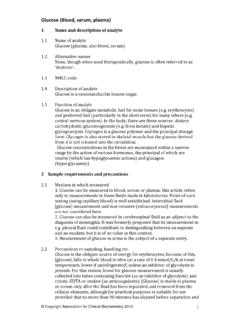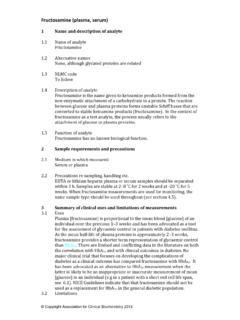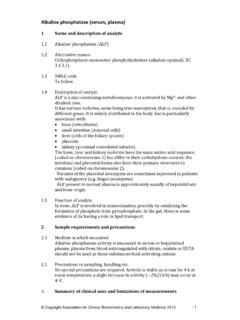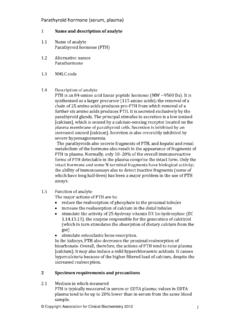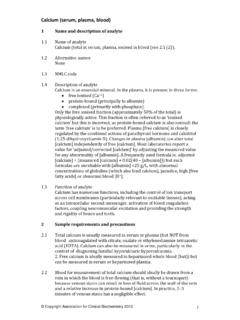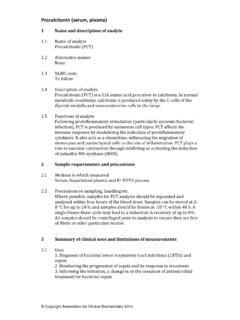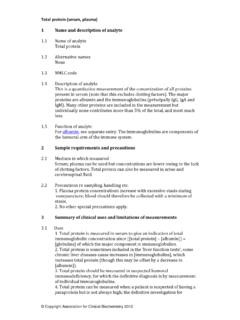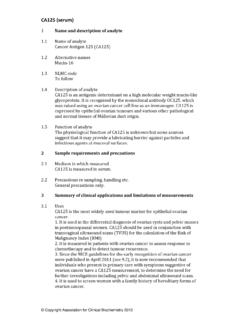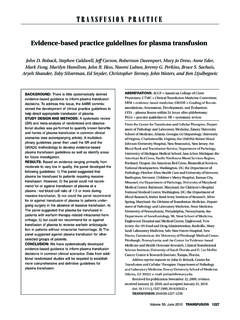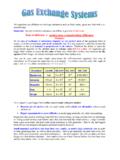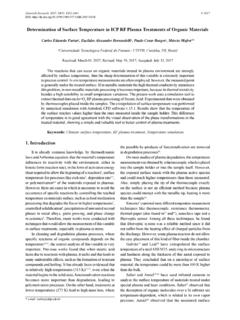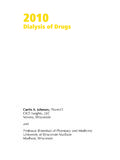Transcription of Potassium (serum, plasma, blood)
1 Potassium (serum, plasma , blood) 1 Name and description of analyte Name of analyte Potassium (K+) Alternative names None NMLC code To follow Description of analyte Potassium is an alkaline metal, atomic number 19. It occurs in the body primarily as free cations. It is the most abundant cation in the body, with 98% being intracellular. Function of analyte The intracellular to extracellular concentration ratio of Potassium determines resting membrane potential and is critical to neural and muscle cell activity. The ratio is controlled by cellular uptake via the Na+,K+ APTase pump on cell membranes and passive diffusion out of cells.
2 Distribution across cell membranes is influenced by numerous factors hormones, principally insulin and catecholamines, acid base status and extracellular tonicity. Aldosterone is the major regulator of body stores of Potassium . Aldosterone exerts its effects on Potassium excretion in the distal renal tubules. Aldosterone secretion release is subject to feedback control by Potassium , independently of the effect of renin: hyperkalaemia stimulates it; hypokalaemia inhibits it. 2 Sample requirements and precautions Medium in which measured 1. Potassium can be measured in serum, plasma (lithium heparin) or heparin anticoagulated whole blood.
3 Potassium is released from platelets during clotting. Therefore, plasma and whole blood concentrations are mmol/L lower than those in serum. 2. Potassium can also be measured in urine (random or 24 h). No preservatives are required. Precautions re sampling, handling etc. Haemolysis: haemolysis causes release of Potassium from erythrocytes leading to falsely elevated results. The effect is not predictable. Haemolysis cannot be detected in whole blood samples. Delayed separation: a delay in separation of the cells from serum or plasma eventually causes a misleading increase in [K+]; so, too, does leaving serum in contact with cells after centrifugation and re.
4 Centrifuging gel separator tubes. Temperature is an important factor: cold storage of whole blood samples before separation will inhibit glycolysis and the energy dependent Na+,K+ ATPase will not maintain the transcellular Potassium gradient. This will cause false increases in [K+] Copyright Association for Clinical Biochemistry 2013. owing to leakage from cells. Conversely, storage above room temperature will initially cause falsely decreased [K+] due to increased Na+,K+ ATPase activity before glucose is exhausted and [K+] rises. Thrombocythaemia: Potassium is released from platelets leading to falsely raised [K+]; a lithium heparin plasma sample should be used for Potassium measurement in patients with thrombocythaemia.
5 Leukocytosis: this initially causes a decrease in [K+] as a result of glycolysis and augmented Na+,K+ ATPase activity: when a leukocytosis is present, measurement should be made on a lithium heparin plasma sample immediately transported on ice to the laboratory; alternatively, whole blood should be measured immediately on a point of care analyser with a Potassium electrode. Once glucose substrate is exhausted, [K+] increases owing to leakage from cells. Fist clenching: this can cause Potassium efflux from cells, leading to a falsely raised [K+]. Contamination: contamination with K EDTA may occur when blood is poured from one collection tube to another.
6 3 Summary of clinical uses and limitations of measurements Uses 1. Diagnosis of hypokalaemia and hyperkalaemia. 2. Monitoring patients at risk of developing hypokalaemia or hyperkalaemia (see section 7). 3. Calculation of the anion gap in acid base disturbances. 4. Calculation of the osmolal gap. Limitations Measurement of Potassium cannot provide information as to the cause of either hyper or hypokalaemia, nor is it a reliable indicator of total body Potassium . Note that diagnostic and action values for [K+] in this article refer to measurements in serum unless stated otherwise. 4 Analytical considerations Analytical methods Many techniques are available to measure Potassium including:, ion.
7 Selective electrodes (ISE), atomic absorption, spectrophotometry and flame photometry. Most laboratories and point of care testing (PoCT) devices use ion selective electrode methods, with the other methods employed almost exclusively by large reference and research laboratories. Potassium electrodes have liquid ion exchange membranes consisting of an inert solvent in which neutral carrier substances, valinomycin, are dissolved. The electrode membrane is in contact with both the test solution and an internal filling solution. The internal filling solution contains Potassium ions at a fixed concentration. Because of the particular nature of the membrane, the test ions will closely associate with the membrane on each side.
8 The membrane EMF is determined by the difference in concentration of Potassium ions in the test solution and the internal filling solution. The EMF develops according to the Nernst equation for a specific ion in solution. Copyright Association for Clinical Biochemistry 2013. Reference method Flame photometry Reference material Potassium chloride (Standard Reference Material (SRM) 918). Interfering substances None Sources of error: Sources of error with ISEs are: lack of selectivity protein coating of the ion selective membrane contamination of the membrane by competing ions. 5 Reference intervals and variance Reference interval (adults): serum mmol/L Reference intervals (others): The following ranges are for plasma samples neonates: mmol/L infants: mmol/L children 1 16 y: mmol/L Extent of variation Interindividual CV: Intraindividual CV: Index of individuality: CV of method: < Critical difference: 14% Sources of variation Consumption of foods high in Potassium may contribute to variations in its concentration.
9 Also, [K+] may vary in relation to a high carbohydrate meal as this stimulates insulin release and thus cellular uptake of Potassium . An acute but transient rise in plasma [K+] occurs during and immediately following exercise. 6 Clinical uses of measurement and interpretation of results Uses and interpretation 1. Diagnosis of hypokalaemia and hyperkalaemia Hypo or hyperkalaemia may be suspected on clinical grounds cardiac arrhythmia or ECG changes. In many cases, however, the diagnosis is an incidental finding when Potassium is measured on a urea and electrolytes' or renal function' profile. Potassium should also be measured when investigating conditions associated with with hypo or hyperkalaemia (see section 7) and when monitoring patients on drugs known to cause hypo or hyperkalaemia (see section 7).
10 2. During treatment of hypo and hyperkalaemia. 3. Calculation of the anion gap in acid base disturbances The serum anion gap is calculated as: ([Na+] + [K+]) ([Cl ] + [HCO3 ]) Copyright Association for Clinical Biochemistry 2013. The normal anion gap is 10 18 mmol/L. A high anion gap can help elucidate the cause of a metabolic acidosis. The urine anion gap is calculated as: ([Na+] + [K+]) ([Cl ]) In a patient with hyperchloraemic (normal serum anion gap) metabolic acidosis, a negative urine anion gap suggests gastrointestinal loss of bicarbonate ( diarrhoea). A positive urine anion gap suggests impaired renal distal acidification ( renal tubular acidosis).

